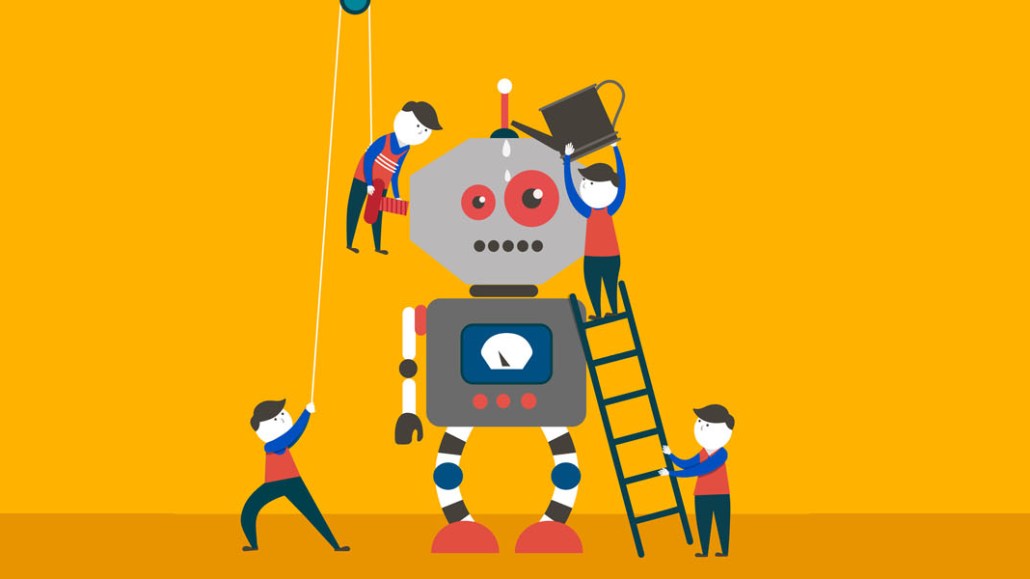Save 50% on a 3-month Digiday+ membership. Ends Dec 5.

U.K. sports publisher GiveMeSport has used its proprietary technology to help grow its Facebook audience to an impressive 25 million followers. Now, it’s integrating artificial intelligence from its new owner, Breaking Data Corp., to give it an advantage over competitors.
The publisher is using AI to play at both ends of the news spectrum — analysis and reaction pieces as well as breaking news. Before this, most of the publisher’s 2,000 monthly articles, created by 14 full-time and 50 freelance writers, were reaction pieces.
The new program also frees up writers’ time to focus on longer-form 1,500-word articles, which carry more ad space around them.
“There are lots of talented artificial intelligence teams globally,” said Nick Thain, CEO of Breaking Data, which acquired GiveMeSport at the end of 2016. “Where Breaking Data separates itself is by understanding the language of social media, the abbreviations and vernacular, how language is adapting is changing, the first time something like Throwback Thursday was used.”
Here’s how the media company is using artificial intelligence in the newsroom.
News gathering and event identifying
Using natural language processing, Breaking Data’s technology scans Twitter every second, sifting through relevant tweets around predetermined keywords, like sports teams, player names, team names, clubs, leagues or sports grounds. This content is filtered and verified; organized into categories like “major event,” “related news” or “marquee news”; and sent as alerts to journalists in a BreakingSports Slack channel, giving the edit team a head start on announcements, particularly during periods like player transfer windows. GiveMeSport is in the process of using Breaking Data’s technology to pull together other publicly available data sources like Facebook, Reddit and Wikipedia.

Ad position: web_incontent_pos1
Countless social listening tools are available, but Thain explains this platform also highlights potentially inaccurate tweets by identifying trusted and reliable sources: For instance, when it was announced that footballer Neymar would join Paris Saint-Germain for €222 million ($261 million), the AI platform could track when the content first emerged on Twitter and label the account as a credible authority.
As the AI platform’s understanding of language grows, it identifies deviations in the norm around specific areas. One hypothesis, said Thain, is that it could scrape the tweets within a one-mile radius of a football stadium. A physical therapist might tweet regularly, then after a tough day might send out a number of tweets complaining about the workload. This change in frequency and topic would be noted and sent as an alert to journalists in the Slack channel, who could then contact the specific club and investigate whether a player has been injured.
Managing Facebook distribution
Facebook is by far the publisher’s biggest distribution platform. GiveMeSport’s journalists also write the Facebook posts and the headlines for their articles. The publisher’s proprietary tech is embedded in the content-management system and scores the writer out of 100 on the likelihood of the post getting high click-through rates or engagement, without the post becoming clickbait. The technology analyzes how the word combination, sentence structure and image will resonate with the intended audience.
“It could be as simple as identifying a capitalized word in the title, which Facebook users might be fed up with. Or it could identify that Manchester United fans prefer not to be referred to as MU or the Red Devils,” said Thain. “It supports the writers in what they are naturally skilled to do.”
“Distribution is a science; we don’t want to leave this to chance,” he added. “AI gives us a further advantage.”
Ad position: web_incontent_pos2
Tying content to emotion
GiveMeSport is currently undergoing a manual process in which writers tag each story in the CMS according to a range of about 30 predetermined emotions that go beyond happy and sad — like tribal, debatable or relatable — to organize the content based on the emotional rewards they satisfy. AI can build out this small analysis to historical data sets. The theory is that understanding this deeper net of emotions and how they connect to users will predict performance.
“Sport is all about emotion,” said Thain. “It’s about feeling that you belong to something, about feeling that you want to tell someone about what you’ve read; it’s about feeling that a story is unmissable or that you relate to the experience within it.”
More in Media

What publishers are wishing for this holiday season: End AI scraping and determine AI-powered audience value
Publishers want a fair, structured, regulated AI environment and they also want to define what the next decade of audience metrics looks like.

Digiday+ Research Subscription Index 2025: Subscription strategies from Bloomberg, The New York Times, Vox and others
Digiday’s third annual Subscription Index examines and measures publishers’ subscription strategies to identify common approaches and key tactics among Bloomberg, The New York Times, Vox and others.

From lawsuits to lobbying: How publishers are fighting AI
We may be closing out 2025, but publishers aren’t retreating from the battle of AI search — some are escalating it, and they expect the fight to stretch deep into 2026.
Ad position: web_bfu





